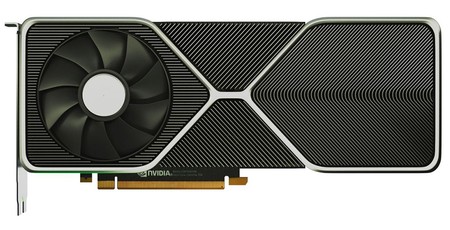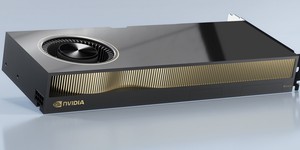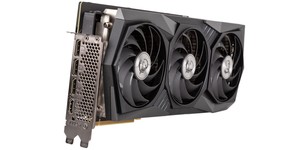
Nvidia has today brought to market the first gaming-oriented GPU to feature the company’s Ampere architecture: The RTX 3080 Founders Edition is available to order now for £649 ($699 in the US), with custom variants from Nvidia’s partners expected to go on sale tomorrow.
Kickstarting what looks to be an exciting few months for PC gamers, the RTX 3080 FE is launching for the same price as the RTX 2080 did in 2018 (in fact, the RTX 2080 Founders Edition was $100 more) and is claimed to offer up to 2x the performance. Sadly, that claim will for now need to remain a claim (at least on these pages), as bit-tech has not been included on the initial sample list for reviews. We’re scrambling to obtain and benchmark partner cards as fast as we can, but for now let’s contextualise things with a good ol’ fashioned specs table.
| RTX 3090 | RTX 3080 | RTX 3070 | RTX 2080 Ti | RTX 2080 Super | RTX 2080 | RTX 2070 Super | |
|---|---|---|---|---|---|---|---|
| Launch date | Sep-20 | Sep-20 | Oct-20 | Sep-18 | Jul-19 | Sep-18 | Jul-19 |
| MSRP | $1,499 | $699 | $499 | $999 | $699 | $699 | $499 |
| Architecture | Ampere | Ampere | Ampere | Turing | Turing | Turing | Turing |
| Codename | GA102 | GA102 | GA104 | TU102 | TU104 | TU104 | TU104 |
| Process | 8nm | 8nm | 8nm | 12nm FFN | 12nm FFN | 12nm FFN | 12nm FFN |
| Transistors | 28.3 billion | 28.3 billion | 17.4 billion | 18.6 billion | 13.6 billion | 13.6 billion | 13.6 billion |
| Die Size | 628.4mm2 | 628.4mm2 | 392.5mm2 | 754mm2 | 545mm2 | 545mm2 | 545mm2 |
| PCIe | 4 | 4 | 4 | 3 | 3 | 3 | 3 |
| SLI | Yes | No | No | Yes | Yes | Yes | Yes |
| CUDA Cores | 10,496 | 8,704 | 5,888 | 4,352 | 3,072 | 2,944 | 2,560 |
| Tensor Cores | 328 | 272 | 184 | 544 | 384 | 368 | 320 |
| RT Cores | 82 | 68 | 46 | 68 | 48 | 46 | 40 |
| Texture Units | 328 | 272 | 184 | 272 | 192 | 184 | 160 |
| ROPs | 112 | 96 | 64 | 88 | 64 | 64 | 64 |
| L2 Cache | 5MB | 5MB | 4MB | 5.5MB | 4MB | 4MB | 4MB |
| Base Clock | 1,400MHz | 1,440MHz | 1,500MHz | 1,350MHz | 1,650MHz | 1,515MHz | 1,605MHz |
| Boost Clock | 1,695MHz | 1,710MHz | 1,725MHz | 1,545MHz | 1,815MHz | 1,710MHz | 1,770MHz |
| Peak TFLOPS | 35.6 | 29.8 | 20.3 | 13.4 | 11.2 | 10 | 9.1 |
| Memory | 24GB GDDR6X | 10GB GDDR6X | 8GB GDDR6 | 11GB GDDR6 | 8GB GDDR6 | 8GB GDDR6 | 8GB GDDR6 |
| Memory Data Rate | 19.5Gbps | 19Gbps | 14Gbps | 14Gbps | 15.5Gbps | 14Gbps | 14Gbps |
| Memory Interface | 384-bit | 320-bit | 256-bit | 352-bit | 256-bit | 256-bit | 256-bit |
| Memory Bandwidth | 936GB/s | 760GB/s | 448GB/s | 616GB/s | 496.1GB/s | 448GB/s | 448GB/s |
| TDP | 350W | 320W | 220W | 250W | 250W | 215W | 215W |
While Ampere is very much an evolution of Turing, which was something of a revolution, there are still some big changes to take note of. Nvidia’s use of Samsung’s 8nm process brings with it greater transistor density and power efficiency. A redesigned Streaming Multiprocessor (SM) sees the theoretical maximum FP32 processing power doubled, which is why the TFLOPs are so much higher in the 3000 Series cards. The RT Cores and Tensor Cores have also both been upgraded, bringing performance improvements in specific maths. The final two key changes are a move to GDDR6X (for RTX 3090 and 3080 anyway) and PCIe 4.0, significantly increasing memory bandwidth and PCIe bandwidth respectively. We’ll cover each of these changes in greater detail when it comes to review time.
The RTX 3080 uses a trimmed down version of the GA102 GPU, a beastly die with over 28 billion transistors crammed into a die size of 628.4mm2. Compared to RTX 2080, it has more of pretty much everything: CUDA Cores, RT Cores, Texture Units, ROPS, cache, memory, and memory bandwidth. Tensor Cores are the exception, as Ampere halves the number you get in each SM, but with each Tensor Core operating 2x or 4x better depending on the workload, the outcome is the same. In terms of clocks, Nvidia is keeping things roughly on par with the original RTX 2080. Despite the new process bringing better power efficiency, the sheer quantity of those extra transistors and processing blocks mean power consumption has still gone up significantly: 320W is 70W more than even the RTX 2080 Ti.
More power of course means more heat, and to deal with that Nvidia has another entirely new cooler for its Founders Edition cards. The PCB is very compact, but the cooler is longer than before, and the significant overhang sees Nvidia pulling air directly through the card (and out straight towards the intake fans of CPU air coolers in a typical setup). Quite how successful this is and the implications of it remain to be seen, but one assumes it was a necessary step to avoid the card becoming gigantic or an overheating disaster.
Without a Founders Edition card of our own, we’re unable to bring you the performance and analysis we usually would, so we’ll direct you instead to our sister site HEXUS. In the meantime, we’ll keep working on getting you some more detailed coverage of the various partner cards expected to become available from tomorrow.
The Nvidia GeForce RTX 3080 Founders Edition is available now for £649 (or $699 in the US). More information is available on the official website.

MSI MPG Velox 100R Chassis Review
October 14 2021 | 15:04








Want to comment? Please log in.